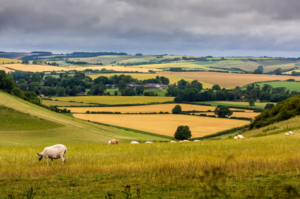 Idyllic countryside life comes with a whole host of upsides. Clean air, room to roam, peaceful silence and beautiful scenery to name a few – but does it also have to come with slow broadband? Anyone who has spent time in a remote or rural area will know that an internet connection can be hit or miss at the best of times. While some parts of the UK are taking advantage of the rollout of download speeds topping 1,000Mbps, other households are struggling to reach double figures. But does this have to be the case? And what might change in the future? In this article we explore why broadband speeds in UK towns and cities are often faster than in the countryside, plus what you can do to bring a faster internet connection to your rural home.
Idyllic countryside life comes with a whole host of upsides. Clean air, room to roam, peaceful silence and beautiful scenery to name a few – but does it also have to come with slow broadband? Anyone who has spent time in a remote or rural area will know that an internet connection can be hit or miss at the best of times. While some parts of the UK are taking advantage of the rollout of download speeds topping 1,000Mbps, other households are struggling to reach double figures. But does this have to be the case? And what might change in the future? In this article we explore why broadband speeds in UK towns and cities are often faster than in the countryside, plus what you can do to bring a faster internet connection to your rural home.
Is rural broadband always slow in the UK?
The simple answer is no. Slow broadband can be considered anything less than 'superfast', which translates to a download speed of 30Mbps. Ofcom estimates that 96% of UK homes can access average download speeds of more than 30Mbps, some of which will be in rural villages and countryside locations. If you are unsure what category your internet connection falls into, read our article ‘What broadband speed do I need?’.
However, while it may not necessarily always fit the definition of slow, rural broadband is generally slower than what households will experience in urban areas. The communities left out of the UK's fibre rollout so far will, along with many isolated properties, still not be able to access superfast broadband. A UK parliament report conducted in 2021 found that around 134,000 hard-to-reach homes would not be able to benefit from the fibre rollout, leaving those residents reliant on other types of broadband. This will likely be a standard internet connection, though Ofcom calculated that around 43,000 UK premises still have no fixed broadband at all. The advancement in satellite and mobile broadband technology could create more options for rural households in the future, but it is not a common method of internet connection at the time of writing. We explain the different types of broadband available in the UK in our article ‘Which broadband is best?’.
Rural homes are far less likely to be able to access the very fastest broadband speeds, calling into question the feasibility of the UK Government's commitment to deliver 1,000Mbps-capable broadband across the whole country by 2025. So while not all rural areas of the UK suffer with slow broadband, a significant number of rural households face reduced speeds or no connection at all. Those that are able to receive a good connection are unlikely to be able to match the speed of households in more urban areas.
Why are broadband speeds slower in rural areas of the UK?
The UK’s broadband network is currently reliant upon a few different forms of physical infrastructure. Some homes are fully connected by fibre-optic cables, some by copper wiring, many by a combination of the two, and others by Virgin Media’s coaxial cables. All of these systems require cables to be physically installed in your home and connected to a street cabinet.
For rural homes, the nearest street cabinet could be miles away. The longer the cabling used, the longer the data being sent will take to travel to its destination, so the slower the connection. In addition, laying miles of cabling costs money, which service providers and governments may be reluctant to spend. If a home does not have modern cabling infrastructure available, any internet connection will need to use old copper phone wiring, which is much slower. The combination of the existing cabling technology in use in the UK weakening over long distances and a lack of investment mean rural homes are often left with slow internet or none at all.
Types of broadband available in rural locations of the UK
There are multiple types of broadband connection available in the UK. What exactly is available in your home will depend on the infrastructure in your area and the coverage of internet service providers. Here are the types of broadband that are most relevant to people living in rural locations.
Fibre broadband
This is the main type of broadband in the UK and comes in two main forms: fibre to the property (FTTP) and fibre to the cabinet (FTTC). FTTP is also called full fibre. FTTC, or standard fibre, uses existing copper phone wires to connect your home to a cabinet in the street, with modern fibre-optic cables then covering the rest of the connection. You will need a landline for this type of broadband. Full fibre uses fibre-optic cabling to cover the whole connection. It is much faster as information travels more quickly along fibre-optic cables than along copper wiring.
You should be able to access superfast speeds of at least 30Mbps and up to 1,000Mbps if your home is able to receive a fibre connection. Many rural areas are covered by fibre broadband, with the total number steadily increasing as the UK’s rollout project continues. However, not every home or area will be able to support the required cabling infrastructure.
You can compare a range of providers by using a comparison service such as Uswitch* to find out exactly what is available in your area.
Standard broadband (ADSL)
Standard broadband, or ADSL (Asymmetric Digital Subscriber Line) broadband, uses the UK’s existing network of phone lines to connect your home to the internet. UK landline connectivity covers a huge amount of the country, so is the most commonly available type of broadband. However, it is also the slowest and oldest. Many rural homes will still rely on this type of internet connection, even though download speeds can be less than 10Mbps in some locations. If your home does not have a phone line, you cannot get ADSL broadband without having one installed.
Mobile broadband
Mobile broadband does not require the cabling infrastructure of fibre broadband, so could be a good alternative for hard-to-reach homes. The technology connects you to the internet through the 4G or 5G networks, however its availability is currently limited almost exclusively to households in urban areas.
4G speeds can reach 30Mbps, while 5G can go as fast as 1,000Mbps, so could be a game-changer for many rural users once the technology is more widely rolled out. However, if you cannot get a good mobile signal in your home, you are unlikely to have much luck with mobile broadband, as both systems use the same technology. You can find out more about mobile broadband in our article ‘What is mobile broadband?’.
Satellite broadband
Satellite broadband is even more suited to reaching remote locations than mobile broadband. The direct satellite connection does not require extensive cabling or local infrastructure, just a dish on the side of your home pointing in the right direction. It is one of the newest types of broadband, but unfortunately the least likely to be available to your household. The installation costs are high and the availability is low, but it could theoretically reach any of the most rural locations in the UK in the future.
Will rural broadband get faster?
Most likely, yes. Broadband technology is advancing and the UK’s average broadband speed is getting faster. However, the UK’s upgrade is not necessarily happening evenly. It may be that speeds in urban areas get faster and faster, pushing the national average up, while people living in some rural areas continue to struggle for usable download speeds.
There is also the prospect that as internet habits change and the need for faster speeds rise, technological advances are outstripped by growing demand. However, the rollout of fibre broadband and the prospect of widespread mobile and satellite connections should give struggling rural internet users cause for hope.
How to speed up your broadband
There are ways to speed up your broadband without needing to lay miles of fibre-optic cables from your remote cottage to the nearest town. These solutions may not turn a poor broadband connection into a good one, but they might be able to help you make the most of the internet speed you can receive.
Connect fewer devices
If you have a slow broadband connection, overloading your router with multiple devices will only make things worse. Disconnecting devices that are downloading files or streaming music or video will increase the available speed for the rest of the network. So try turning your smart speaker off while you download a large file, or make sure you do not have multiple devices connected while you are trying to stream a film.
Rearrange your home
Where your devices are located in relation to your router could have a big impact on your broadband speed. Your Wi-Fi signal can be weakened by anything from thick walls, to nearby electrical equipment, to the positioning of furniture. Counter this by moving your router to the centre of your home and keeping it on a raised surface, not on the floor.
Change broadband provider
If you are not getting the broadband speed you need, it could be because you are with an under-performing provider or you are signed up to the wrong package. Some rural households may be limited in which providers they can choose, but if there are multiple options available you should consider switching for a better deal. We explain how easy switching can be in our article ‘How to switch broadband provider’.
Change broadband type
Whether there are any better deals you can switch to will depend in part on what different types of broadband your home can be served by. Many rural households may have found in the past there were only one or two deals available. However, with the UK’s broadband infrastructure changing, you could find that there is a new type of connection available in your area. Try using the ‘Ofcom broadband checker’ to see if your home can get a different type of broadband to your existing connection.
Look for a rural village broadband specialist
Some small internet service providers can help set up broadband connections for rural homes. This work can sometimes be funded by a special grant, so reach out to companies in your local area.
You could also try contacting rural village broadband specialists that can help you explore the different options available to your property, though you could do some of this research yourself using the ‘Ofcom broadband checker’. These companies help you find out what types of broadband can serve your home and organise a provider to supply the property.
Find out more about rural broadband providers
Make sure to research any provider that claims to offer a broadband connection to your home. Reading online reviews can give a good insight into what other customers have experienced with that provider, while expert reviews can help you learn more about the deals and features offered by that company. Ultimately the decision is up to you, but you can find our detailed reviews of the major UK broadband providers below if you need some guidance.
BT Broadband Review
Virgin Media Broadband Review
Sky Broadband Review
TalkTalk Broadband Review
NOW Broadband Review
EE Broadband Review
Vodafone Broadband Review
Plusnet Broadband Review




